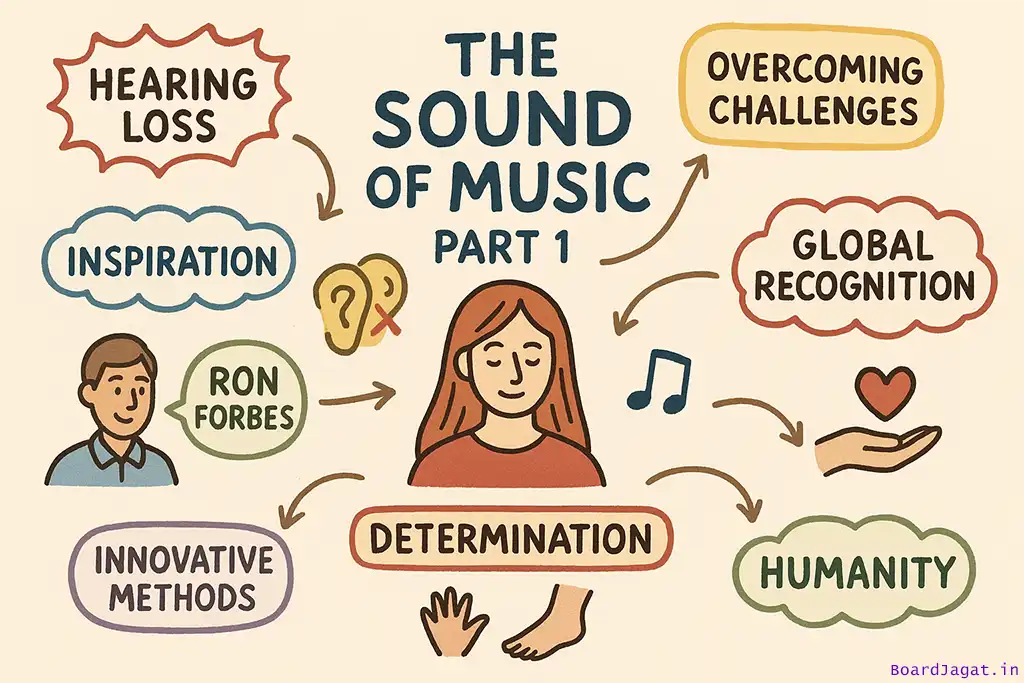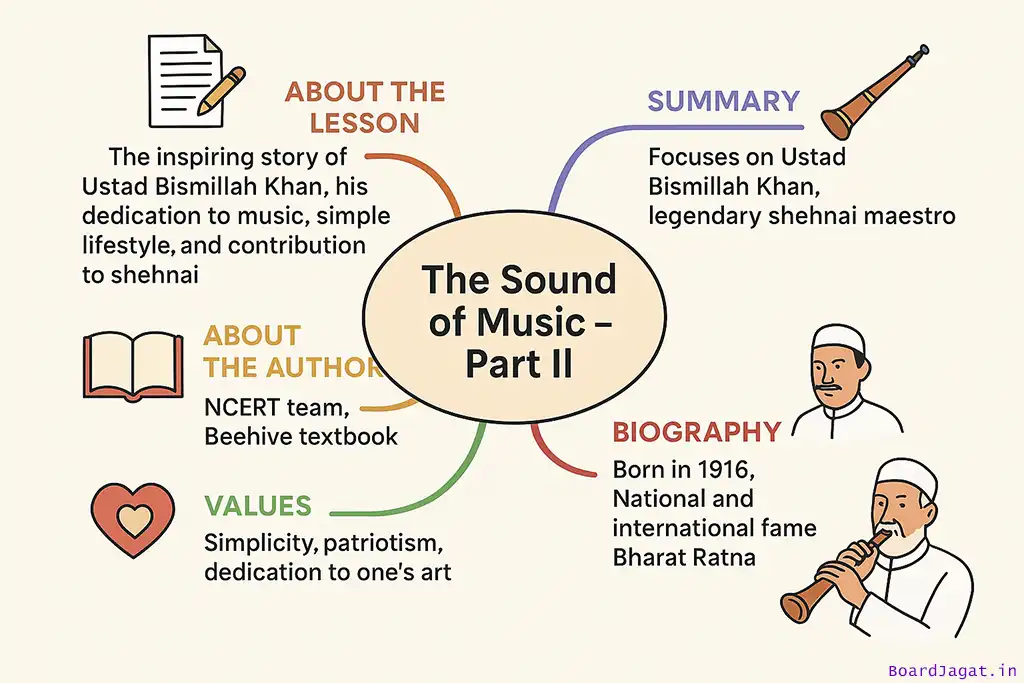Today, in this post, ‘The Sound of Music Summary’, we’ll read the short and detailed summary of Class 9th NCERT English Beehive chapter 2, The Sound of Music.
The Sound of Music Part 1
About the Lesson: The Sound of Music Part 1
“The Sound of Music – Part I” tells the inspiring story of Evelyn Glennie, a world-famous percussionist who overcame the challenge of complete hearing loss. Despite her disability, she achieved excellence in music through sheer determination, perseverance, and an extraordinary sense of sound through other parts of her body. This lesson emphasizes courage, optimism, and the power of hard work.
About the Author: Deborah Cowley
The chapter is written by Deborah Cowley, a Canadian writer, editor, and broadcaster known for writing stories that celebrate courage and human spirit. Her works often highlight individuals who overcome great challenges.
Short Summary of The Sound of Music Part 1
Evelyn Glennie, a Scottish girl, lost her hearing by the age of 11 due to nerve damage. Despite this, she was determined to make a career in music. When her teachers discouraged her, Evelyn did not give up. She met percussionist Ron Forbes, who encouraged her to feel music through vibrations in her body instead of hearing it through ears. Evelyn practiced tirelessly and learned to sense sounds through her skin, feet, and other body parts.
She auditioned for the Royal Academy of Music and got the highest marks in its history. Evelyn became the world’s most sought-after percussionist, performing across the globe and mastering more than a thousand instruments. She won many awards, including the prestigious Soloist of the Year Award. Evelyn also gives free concerts for hospitals and prisons, proving her humility and kindness. Her story inspires us to believe that strong determination and positive attitude can overcome any obstacle.
The Sound of Music Part 1 Summary
“The Sound of Music – Part I” is an inspiring account of Evelyn Glennie, a world-famous percussionist who achieved success despite being profoundly deaf. The chapter narrates her journey from an ordinary Scottish girl to an international music icon, highlighting her courage, determination, and innovative approach to life.
Early Life and Hearing Loss:
Evelyn Glennie was born in Scotland and grew up on a farm. Until the age of eight, she could hear normally. However, her hearing started deteriorating due to gradual nerve damage. By the age of eleven, she had completely lost her hearing ability. Doctors confirmed that nothing could be done, and her teachers discouraged her from pursuing music, believing that a deaf child could not play musical instruments.
Unbreakable Spirit and Determination:
Despite this setback, Evelyn did not give up. She was determined to live a life full of music. While most people would have given up, Evelyn was passionate and refused to accept defeat. She believed that “life should be lived to the fullest” and that disability should not become a barrier to success.
Meeting Ron Forbes – A Turning Point:
Her life changed when she met Ron Forbes, a famous percussionist and music teacher. He saw Evelyn’s potential and decided to help her. Instead of focusing on what she could not do, he taught her a new way to experience sound, through vibrations. He told her, “Don’t listen through your ears; try to sense it some other way.” Evelyn followed his advice and discovered that she could feel the music through different parts of her body.
Learning to Feel Music:
Evelyn began to sense vibrations in a unique way:
- She removed her shoes and felt vibrations of drums through her feet.
- She felt higher notes from the upper part of her body.
- She leaned against drums and xylophones to feel vibrations through her skin, hands, and face.
This innovative method of learning gave Evelyn the confidence to continue her training and improve her skills.
Success and Global Recognition:
At the age of seventeen, Evelyn auditioned for the Royal Academy of Music in London. She created history by scoring the highest marks in the academy’s history. She worked very hard, practicing for hours every day, and mastered thousands of percussion instruments, including the xylophone, drums, and marimba.
Evelyn soon became the world’s most sought-after percussionist. She gave concerts in more than a hundred countries, performed solo in prestigious events, and collaborated with orchestras. Her performances were so powerful that audiences could feel the music deeply, even if they didn’t see her disability.
Awards and Humanitarian Work:
Evelyn Glennie received many awards, including the Soloist of the Year Award from the Royal Philharmonic Society. Despite her success, she remained humble and generous. She gave free concerts in hospitals and prisons, and worked for charity to help deaf children learn music.
Inspiration to the World:
Evelyn’s life story is a shining example of courage and perseverance. She proved that “if you have strong determination and willpower, nothing is impossible.” Her ability to sense music through her body and achieve excellence despite total deafness shows that obstacles can be overcome with dedication.
Key Message:
The story conveys that disability is not a limitation if you have determination, passion, and creativity. Evelyn Glennie’s life teaches us to never give up on our dreams, no matter how big the challenge.

The Sound of Music Part 2
About the Lesson: The Sound of Music Part 2
“The Sound of Music – Part II” tells the inspiring story of Ustad Bismillah Khan, one of India’s greatest shehnai players. This lesson highlights his dedication to music, his simple lifestyle, and his immense contribution to making the shehnai a respected classical instrument. It portrays how he devoted his life to the purity of art, rejecting material wealth and focusing on his passion.
About the Author
The text about Ustad Bismillah Khan is written by the NCERT team as part of the Beehive textbook to educate students about cultural icons of India. It is a biographical narrative based on historical facts and interviews, compiled to showcase his life, struggles, and achievements.
Short Summary of The Sound of Music Part 2
This part of the lesson focuses on Ustad Bismillah Khan, the legendary shehnai maestro. Born in a small village in Bihar in 1916, Bismillah Khan grew up surrounded by music, as his family had a long tradition of musicians. He was fascinated by the shehnai from a young age and practiced it passionately. His dedication brought him national and international fame.
Bismillah Khan played the shehnai at significant occasions, including India’s Independence Day in 1947 from the Red Fort. He traveled worldwide, performing in prestigious venues, yet remained deeply connected to his roots in Banaras and Dumraon. Despite offers to settle abroad, he refused, saying he could not live away from the Ganga and his beloved country.
He received numerous awards, including the Bharat Ratna, India’s highest civilian honor. The lesson teaches values of simplicity, patriotism, and dedication to one’s art. Bismillah Khan passed away in 2006, but his music and humility continue to inspire generations.
The Sound of Music Part 2 Summary
Introduction:
Part II of The Sound of Music introduces us to Ustad Bismillah Khan, one of India’s most revered musicians, who brought the traditional shehnai to the concert stage and gave it international recognition. His life is a story of dedication, simplicity, and devotion to music.
Early Life and Background:
Bismillah Khan was born in 1916 in Dumraon, a small town in Bihar, into a family of musicians. His ancestors were court musicians in the princely states of Bihar. His father, Paigambar Bux, was a shehnai player in the court of Bhojpur Raja. From childhood, Bismillah Khan showed a keen interest in music. At the age of five, he played gilli-danda near the pond of the Bihariji temple and sang the Chaita in the Bhojpuri dialect, earning praise from the local audience.
Journey into Music:
Bismillah Khan’s real journey into music began in Varanasi (Banaras). He often accompanied his uncle, Ali Bux, to the Vishnu temple of Varanasi, where Ali Bux played the shehnai. The young Bismillah would sit captivated for hours and learn by observing. Gradually, he started practicing for hours under the trees of the temple and on the banks of the River Ganga, whose flowing water inspired him to create new ragas.
Rise to Fame:
His dedication soon bore fruit. Bismillah Khan got the opportunity to perform on All India Radio (AIR), Lucknow in 1938, which gave him nationwide recognition. His music was pure and soulful, which touched hearts. A historic moment came on 15th August 1947, when Bismillah Khan was invited to play the shehnai from the Red Fort to mark India’s Independence. His recital of Raag Kaafi on that day became immortal in history.
International Recognition:
Bismillah Khan’s fame was not limited to India. He performed in many countries, including the USA, UK, Afghanistan, Canada, and Iran, earning global respect for Indian classical music. His concerts introduced the world to the richness of Indian traditions.
Simplicity and Love for Homeland:
Despite international fame and numerous awards, including Padma Shri, Padma Bhushan, Padma Vibhushan, and Bharat Ratna (2001), Bismillah Khan remained a humble man. He refused tempting offers to settle abroad because he could not live without the holy River Ganga and the spiritual atmosphere of Banaras. He once said that whenever he is in Mumbai or elsewhere, he misses the temple of Balaji and the flowing waters of Ganga.
Death and Legacy:
Ustad Bismillah Khan passed away on 21st August 2006 at the age of 90. The Government of India declared a day of national mourning in his honor. His music, humility, and love for his roots continue to inspire generations. He transformed the shehnai from a wedding instrument into a concert-worthy classical instrument, making it globally respected.
Message of the Lesson:
The story teaches us that hard work, simplicity, dedication, and love for one’s culture and country can make a person truly great. Ustad Bismillah Khan’s life is a perfect example of how passion combined with humility leads to excellence.

Read Also: The Sound of Music NCERT Solutions